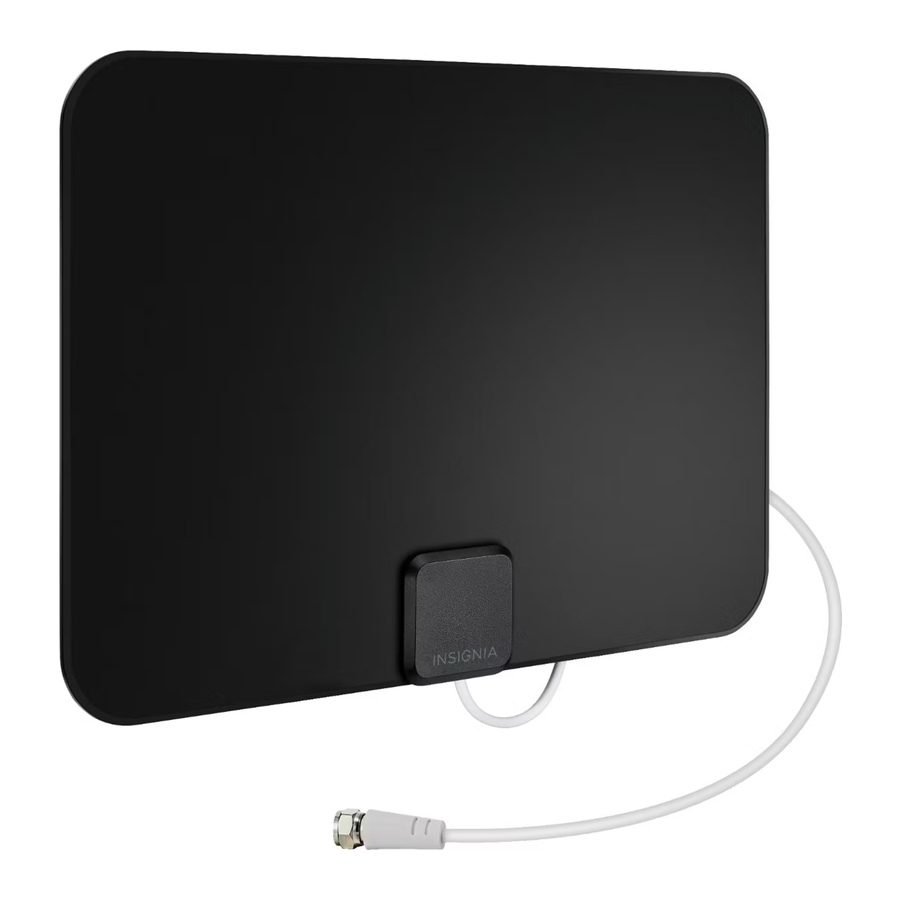Advertisement
Table of Contents
Contents
Insignia NS-ANT200HA - Ultra Thin HDTV Antenna Quick Setup Guide

INTRODUCTION
This antenna is designed for digital over-the-air TV broadcast reception. It can receive the TV signals available in your area in the VHF and UHF bands.
PACKAGE CONTENTS

- Ultra thin antenna
- 10 ft. (3.04 m) coaxial cable (attached)
- 2‐sided foam tape (one large, two small pieces)
- Quick Setup Guide
Before using your new product, please read these instructions to prevent any damage.
FEATURES
- Black/white two-sided design lets you choose the color that blends in best
- Thin antenna that's easy to place and provides ideal reception
- Thin coaxial cable makes cable routing easier without impacting performance
SETTING UP AND USING YOUR ANTENNA
- Select a location to place your antenna. See "Tips for Better Reception" for more information.
Note: This is an indoor antenna. Do not place it outside. - To hang the antenna on the wall, attach double-sided tape to your antenna's top corners, then firmly press the antenna to the wall to secure.
Note: DO NOT perform this step until you have found a location that provides the best reception. You can use tape to temporarily hang the antenna to the wall or other surface.
![Insignia - NS-ANT200HA - SETTING UP AND USING YOUR ANTENNA - STEP 1 SETTING UP AND USING YOUR ANTENNA - STEP 1]()
- Connect the antenna's coaxial cable to your TV, digital converter box, or set-top box:
- TV: Connect the antenna's coaxial cable to the coaxial jack on the back of your TV.
Note: If you have an HDTV with a digital TV (ATSC) tuner, you can connect the antenna directly to the HDTV. Older TVs may require a separate digital TV tuner or digital converter box.
![Insignia - NS-ANT200HA - SETTING UP AND USING YOUR ANTENNA - STEP 2 SETTING UP AND USING YOUR ANTENNA - STEP 2]()
- Digital converter box or set-top box: Connect the antenna's coaxial cable to your digital converter box or set-top box, then connect a video/audio cable (such as an HDMI, coaxial, or AV cable) from your converter box or set-top box to your TV.
![Insignia - NS-ANT200HA - SETTING UP AND USING YOUR ANTENNA - STEP 3 SETTING UP AND USING YOUR ANTENNA - STEP 3]()
- TV: Connect the antenna's coaxial cable to the coaxial jack on the back of your TV.
- Turn on your TV, then press input or source to select the input your antenna is connected to.
Note: Turn on your digital converter box or set-top box if your antenna is connected to either device. - Open your TV's setup menu, then select the "scan" or "channel scan" option. Your TV automatically searches for available channels in your area. See your TV's user guide for detailed instructions.
Note: If you don't receive channels that you want, try moving your antenna to another location, then run the channel scan again.
TIPS FOR BETTER RECEPTION
For the best reception:
- Install the antenna as high as possible to avoid possible obstacles between the antenna and the transmission tower.
- If possible, place the antenna near windows.
- Keep the antenna away from sources of interference such as air conditioners, hair dryers, and microwave ovens.
- Run a channel scan every time you move your antenna.
- If possible, position your antenna toward the transmission tower. To determine which channels are available in your area, visit www.antennaweb.org. Type in your zip code to get help with antenna placement.
- Test the antenna in multiple locations to find the strongest signal.
- This antenna is an indoor antenna. Do not place it outside.
- Run a channel scan monthly to make sure that you are receiving all possible channels.
- Some TVs have a signal strength indicator that can help with antenna placement. Check your TV manual to see if your TV has this feature.
- This antenna works with any TV or device with an ATSC tuner. See your device's manual to check compatibility.
TROUBLESHOOTING
| PROBLEM | SOLUTION |
Cannot find any channels |
|
| Picture quality is good on some channels and poor or no reception on others |
|
| I don't know what digital TV reception I get in my area |
|
| Not all channels are available after performing a channel scan |
|
| I have more than one TV on which I want to view over-the-air TV |
|
| I am not receiving cable and streaming channels after a channel scan |
|
| I want HD channels, but I do not have an HDTV |
|
SPECIFICATIONS
- Range: 35 miles
*Note: Mile range will vary depending on a wide range of environmental and geographic factors - Frequency range:
- VHF range: 174-230 MHz
- UHF range: 470-862 MHz
- Antenna gain:
- VHF: 3dB
- UHF: 2dB
- Cable length: 10 ft. (3.04 m)
- Impedance: 75
![]()

VideosSetting Up Your TV: Antenna Video
Documents / Resources
References
Download manual
Here you can download full pdf version of manual, it may contain additional safety instructions, warranty information, FCC rules, etc.
Download Insignia NS-ANT200HA - Ultra Thin HDTV Antenna Quick Setup Guide
Advertisement






Need help?
Do you have a question about the NS-ANT200HA and is the answer not in the manual?
Questions and answers